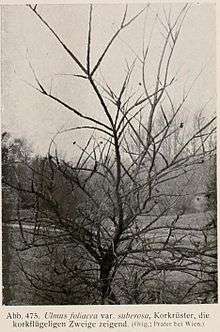''Ulmus minor'' 'Suberosa'
| Ulmus minor | |
|---|---|
 | |
| Cultivar | 'Suberosa' |
| Origin | Central and eastern Europe |
The Field Elm cultivar Ulmus minor 'Suberosa', commonly known as the Cork-barked elm, is a slow-growing or dwarf form of conspicuously suberose Field Elm of disputed status, considered a distinct variety by some botanists, among them Henry (1913),[1] Krüssman (1984),[2] and Bean (1988),[3] and sometimes cloned and planted as a cultivar. Henry said the tree "appears to be a common variety in the forests of central Europe", Bean noting that it "occurs in dry habitats". Green and Richens, however, dismissed var. suberosa as just a genetically random, maritime or juvenile form of U. minor, insufficiently differentiated to merit varietal status, its name a relic of taxonomic conservatism.[4][5] Richens noted (1983) that some Soviet botanists still accorded the tree species status, as U. suberosa. By the proposed rule that known or suspected clones of U. minor, once cultivated and named, should be treated as cultivars, the tree would be designated U. minor 'Suberosa'.[6]
The Späth nursery of Berlin distributed an U. campestris suberosa alata Kirchn. [:'corky-winged'] from the 1890s to the 1930s.[7]
Description
Henry, having seen specimens in Slavonia, Croatia, and in Gisselfelde, Denmark, as well as at Kew, described the tree as having "branchlets of the second to the tenth year furnished with corky wings", but with "leaves and samarae as in the type". Krüssman and Bean report it to be "rather dwarf" in comparison with most U. minor. The Kew specimens (see below) suggest that its slow growth is probably not related to dry habitat. Given the widespread occurrence of variable suberose Field Elm across Europe, it is likely that most photographs of Field Elm with corky flanges on branches do not show the cultivated dwarf variety. Young and semi-mature trees of some Ulmus × hollandica cultivars, notably 'Major', the 'Dutch Elm' of Britain and Australasia, also develop corky bark.
 U. minor 'Suberosa' Białowieża forest, Poland
U. minor 'Suberosa' Białowieża forest, Poland U. minor 'Suberosa' Białowieża forest, Poland
U. minor 'Suberosa' Białowieża forest, Poland
Pests and diseases
See under Ulmus minor.
Cultivation
Field Elms labelled var. suberosa, presumably cultivated vegetatively to preserve the form, have been and continue to be included in a number of botanical collections, notably in central and eastern Europe. A striking specimen so labelled, with thick corky branches and branchlets giving a dense winter silhouette, stands in the Botanic Gardens of Visby in Gotland, Sweden,[8] and others are reported from the University of Copenhagen Arboretum [9] and from the Alexandru Buia Botanic Garden in the University of Craiova, Rumania.[10]
A specimen of Späth's U. campestris suberosa alata was planted in 1897 at the Dominion Arboretum, Ottowa, Canada.[11][12] Three specimens supplied by Späth to the RBGE in 1902 as U. campestris suberosa alata may survive in Edinburgh, as it was the practice of the Garden to distribute trees about the city (viz. the Wentworth Elm);[13] the current list of Living Accessions held in the Garden per se does not list the plant.[14]
Notable trees
Henry and Elwes said there were four specimens at Kew, "of no great size, but of considerable age".
References
- ↑ Elwes, H. J. & Henry, A. (1913), The Trees of Great Britain & Ireland, Vol. VII, p.1888; Private publication, Edinburgh
- ↑ Krüssman, Gerd, Manual of Cultivated Broad-Leaved Trees & Shrubs (1984 vol. 3)
- ↑ Bean, W. J., Trees and shrubs hardy in Great Britain, 8th edition (1988), Murray, London; p.643
- ↑ Green, Peter Shaw (1964). "Registration of cultivar names in Ulmus". Arnoldia. Arnold Arboretum, Harvard University. 24 (6–8): 41–80. Retrieved 16 February 2017.
- ↑ Richens, R. H., Elm (Cambridge 1983), p.83, p. 278
- ↑ Coleman M. (2002) 'British elms.' British Wildlife 13 (6): 390-395.
- ↑ Späth, L. (1930). Späth-Buch 1720 - 1930, Self-Verlag, Berlin.
- ↑ Korkelm in the Botanic Gardens of Visby in Gotland, Sweden
- ↑ U. minor var. suberosa, University of Copenhagen Faculty of Life Sciences,
- ↑ U. minor Miller var. suberosa (Henry), Alexandru Buia Botanic Garden, University of Craiova, Rumania
- ↑ Catalogue of the trees and shrubs in the arboretum and botanic gardens at the central experimental farm (2 ed.). 1899. p. 75.
- ↑ Buckley, Arthur R. (1980). Trees and shrubs of the Dominion Arboretum. Research Branch, Agriculture Canada. p. 138. Retrieved 20 December 2016.
- ↑ Accessions book. Royal Botanic Garden Edinburgh. 1902. pp. 45,47.
- ↑ "List of Living Accessions: Ulmus". Royal Botanic Garden Edinburgh. Retrieved 21 September 2016.
External links
- "Herbarium specimen - L.4233479". Botany catalogues. Naturalis Biodiversity Center. Sheet described as U. carpinifolia var. suberosa (1957)
- "Herbarium specimen - WAG.1852986". Botany catalogues. Naturalis Biodiversity Center. Sheet described as U. campestris suberosa (1901)
- "Herbarium specimen - E00824833". Herbarium Catalogue. Royal Botanic Garden Edinburgh. Sheet described as U. campestris suberosa alata (1902)
- "Herbarium specimen - E00824832". Herbarium Catalogue. Royal Botanic Garden Edinburgh. Sheet described as U. campestris suberosa alata (1902)